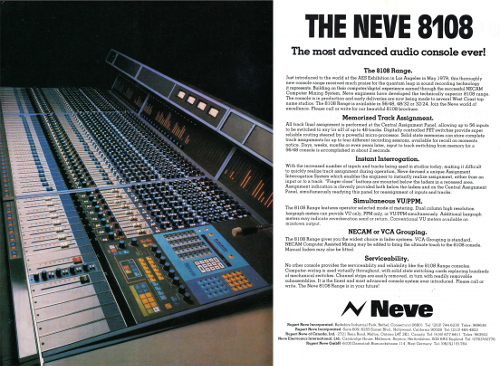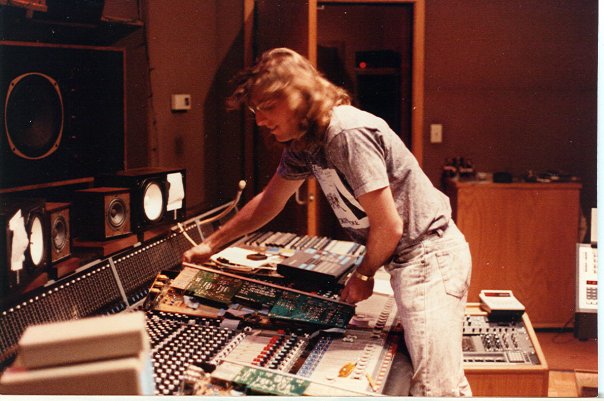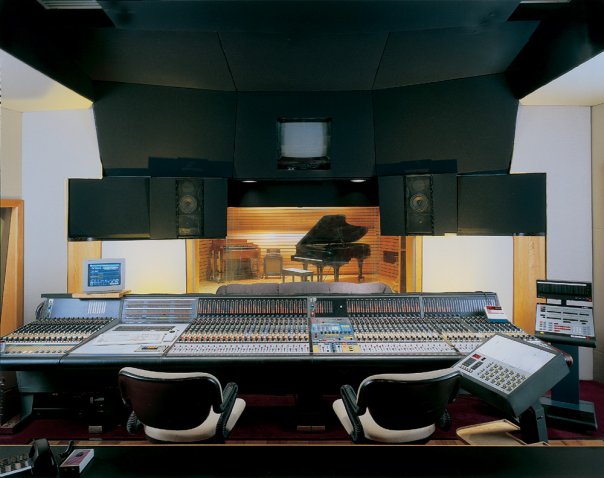|
[?]Subscribe To This Site
|
Neve 8108 Recording ConsoleMessage Board - Neve 8108 Recording Console
"81 and 82 series were ribbon cable consoles and had no motherboards. All the bussing and routing happened in crosspoint racks in the back of the desk and switching was accomplished with discrete FET transistors. These cards were controlled by an S100 buss single board computer with a Z-80 (or similar) processor. Most of the cards in those racks were BA 700 series cards. So the cards were roughly S100 sized (a little bigger I think because the S100 card was mounted on a carrier board that was a little bigger.) The cards were several types and configured for different routing functions. Multitrack busses were done on one type, auxes another (as I recall...) and so on. Most consoles used 2 or 3 signal routing racks and larger ones used more (there were a couple really huge, for the time, custom consoles made - they went up to 64 inputs in standard configurations.) The crosspoint racks had massive amounts of ribbon cable connecting them, together. The ribbon cable were less of a problem in terms of signal degradation than you might think because they carried line level signals driven from amplifiers and did not carry the actual summing busses. The busses were virtual earth (current summing) busses (a first for Neve in large music desks) and they were short because they were all in the racks which were compact. The input modules came in two main flavors, There were inputs and rev returns and they were mostly mono but there were some stereos. The i/o was mostly in and out of the patchbay which were plastic ADC type jacks mounted on cards that had actively balanced i/o on them. The main outputs were done on big amplifiers on six channel cards in a rack under the bay that most often had really big fat transformered outputs on them. Mic and some line inputs were done on the backs of the i/o modules. There were odd cards all over the inside of the console that are hard to find... and I have blown up a couple phase meter cards because for some reason that connector/card was not keyed so they could be reverse plugged - all gray cable with no polarization strip - bummer. Neve had hired a whole crew of design engineers right out of school who were trained in modern manufacturing and packaging technologies that were geared to computer and automation systems more than audio ... they knew nothing about audio really. They were chartered to come up with a console that had nearly zero hand-looming and to do whatever else they could to make the consoles cheaper to manufacture. Thus these were the first IC based music consoles and at the time thus meant 741 generation parts as 5534 was new and still pretty expensive and only used selectively. In there are a lot of Harris (and other) quad 4741 IC's and in a few places they used a quad chip with a strange pinout that did not conform to the TLO74 style "output in the corners" layout... so chip upgrades are a pain in some part of the anatomy. The console took power unregulated from massive power supplies that were just big transformers, rectifiers and filter caps and the console used local regulation on each channel and everywhere else using TO-220 (78xx/79xx) type flat pack regulators on the strip boards that ran the length of the module. There is a wire hanging out of the bottom of every module that is a ground. It MUST me connected as this is what the regulators NEED in order to function. Also... when commissioning these consoles it is absolutely imperative that the power and ground distribution is completely solid everywhere and that the power supply startup sequencing (built into the supplies) has the + and - audio supplies coming up at the same time. If the grounds are off either by being unplugged (in line bullet connectors) or if there is a bad crimp, loose binding screw or whatever in the in-line connectors in the ground wiring you may hear the sound of regulators popping. Fred Hill told me that once he dropped a screwdriver on to the main PSU distribution blocks under the producer desk (he was commissioning a console) and he blew almost ALL the regulators in the console - it sounded like loud popcorn or small fire crackers - It's a pain in the butt to get to them to so it took him days and a lot of regulators to fix the console. I've blown up a few modules - it's a thing you will experience if you live with one. ...and I can go on but no time now. If someone hires me to rebuild another one of these and I accept the job (which means the customer is going to be spending a ton of money and it probably won't happen) I can justify spending some more time expanding on this commentary... so here we go with the module and EV numbers. note: variations for film existed that may have had other module designations but mostly I saw the same modules and modules and rack wiring was modded to do film stuff. 8108 series
mono channel MODULE is 34136 mic/line input sub module 80000 (EV10712/EV10713) filters sub module 80007 (EV10714/EV10715) equalizer sub module 80008 (EV10716/EV10717) aux send sub module 80009 (EV10718/EV10719) group control sub module 80140 (OR 80010?) (EV10740/EV10741) mono rev MODULE is 34137 rev send/retrun sub module 80003 (EV10752/EV10753) filters sub module 80007A (EV10714/EV10715) equalizer sub module 80008 (EV10716/EV10717) aux send sub module 80009 (EV10718/EV10719) group control sub module 80140A (OR 80010A?) (EV10740/EV10741)
8128 series (8128/8132/8148 etc) are very similar - the primary difference between 8108 and 8128 etc is for the most part system configuration and center section
mono channel MODULE is 81280 mic/line input sub module 81000 (EV10972/EV10978) filters sub module 80007 (EV10714/EV10715) equalizer sub module 80008 (EV10716/EV10717) aux send sub module 80009 (EV10718/EV10719) group control sub module 81010E (EV10973/EV10974) mono rev MODULE is 81281 rev send/retrun sub module 81003 (EV10975/EV10976) filters sub module 80007A (EV10714/EV10715) equalizer sub module 80008 (EV10716/EV10717) aux send sub module 80009 (EV10718/EV10719) group control sub module 81010A (EV10973A/EV10974A)
8232 and 8248 - I don't seem to have a book on the shelf for this so I have to dig through the files and I don't want to spend the time now... but the filters, EQ, aux and routing are direct descendants of the 81xx consoles and may even be the same boards - the routing control where the panner etc. are will be different and probably the input sub module as well. mono channel MODULE is 81380 there was no dedicated return module
5104 and 5114 consoles mono channel MODULE is 83012 (2 band EQ no dynamics) or 83049 (4 band EQ + dynamics) 83012 input/filters sub module 83063 83049 input/filters/dynamics sub module 83022 83012 equalizer sub module 83064 83049 equalizer sub module 83002 aux send sub module 83003 83012 group routing sub module 83064 83049 group routing sub module 83064 pan/solo etc sub module 83006 mono group status MODULE is 83015 stereo channel MODULE is 83017 (no EQ on either one) input sub module 83000 aux 1-4 (mono) sub module 83003 group routing sub module 83062 balance etc sub module 83001
5106 and 5116 consoles mono channel MODULE is 83010 input/filters/dynamics sub module 83022 equalizer sub module 83002 aux send sub module 83003 group routing sub module 83003 or 83014 pan/solo etc sub module 83006 mono group status MODULE is 83015 stereo channel MODULE is 83011 or 83514 (no EQ on either one) input sub module 83000 aux 1-4 (mono) sub module 83003 group routing sub module 83014 balance etc sub module 83001 stereo group status MODULE is 83016
I'm not going to get in to V Series. You'll find that V series are also sharing many of the same filter, EQ, aux circuits from 81xx and they added dynamics from 51xx consoles. VR forced revamp in everything to add recall though the actual circuits are, again, very similar. Mainly all these series shared a lot of the audio circuits and differed in routing and features like buss count etc. The 81/82 series had that stupid centralized routing and therefore a LOT of FET switching so the FET's were a big issue in those desks. 51 and V have all the routing to busses as hard switches for the most part. It can be said that the V really fell out of both series and just expanded the buss counts and added music features. So... when you really get down to it the 81/82 music consoles are really earlier generations of what became the V series consoles but with a ton of FET switching. Since they are less dough and run a little cooler they come out as a good candidate for being the common man's V. They still need to be recapped but the caps tend to last longer. Neve got kicked in the ass when they took all this to the V and crammed twice as much circuitry in to the same space with a motherboard under the modules that choked off air flow... so if you can deal with the idiosyncrasies and a few less features you can look at 81/82 consoles keeping in mind that they are mostly older. The 8108 was introduced in 1980 and I had to rebuild one of the very first ones that came in to New York. The client did not have the bread to do the whole thing so it was a bit of a nightmare all around. I won't get seriously involved any more with 51/81/82 desks, and V/VR for that matter, unless we are doing a complete soup to nuts restoration - in the shop - that includes, complete recapping, replacing a LOT of switches and then going through the racks (in 81/82) to select and upgrade FET's. This is expensive, takes a lot of time and we don't do many. I am getting a similar attitude toward 8058/68/88 consoles only because so many of them have aux switcher routers that have been modified badly or too much... to the point where I am designing and (and almost ready to manufacture if a client comes along that can justify doing it) a whole gut out and replacement set of boards for those modules that adds the relays, logic and additional amplifiers and buffers to get them to do everything right while keeping everything in the audio path done the Neve way. I have reviewed this work with some people at Neve to get opinions and so far they have not taken issue with any of it. You are looking at 225 to 250K to get an 8068 done up all the way with new switcher/routers and moving faders... so we may do one or two in the next three years so that is another "not very many done here" consoles and that's fine with us. I'm not fishing for work here, by the way, I'm just saying that it is best to do things complete and the right way but that takes effort and money no matter what - and this is true of many older consoles. It's up to the owner/user whether or not they want to make the investment or want to live with a geriatric console that can be cranky. If you want it right you almost always spend more money for the completed console that you can possibly sell if for easily. Now we are seeing a lot of whole input strips and various EQ and Dynamics modules floating around these days
post note: The 88R consoles are NOT V series desks really - they are very upgraded and don't have the same maintenance and aging issues - the audio performance is vastly superior. I am getting to know that console now and I thing this is probably the best of the large format consoles Neve has made. The SSL 9K consoles are very good and very HiFi sounding, very transparent. The 88R consoles are more musical sounding to my ears (and those of many others...) but since both of these are well over 500K in sizes that people want to use they are a little out of site for most of us. John Klett / Tech Mecca http://www.technicalaudio.com"
- Neve 8108 New River Studios - Jim Thomas, Engineer - Studio A - 1989. Photo courtesy of Larry Janus. "An excellent write up! Must have taken you ages! Smile Yes, indeedy, I've often mentioned the lunchtime beer and sandwich sessions that were used at the conceptual stage of N78 (as the 8108 project development was named). That was the first big mistake because it was Neve engineers deciding what studios would want, rather than the other way around. Then, as you described, the brief was to get away from the collosal man hours of wiring of previous generation consoles. I have all the man hour reports on those consoles (not close at hand, alas) but, from memory, around 500 man hours just to wire the frame would not be the exception. Then add the modules and metalwork and up to six weeks of testing on top of that! The 8108 was the first steel monoque construction console Neve had ever tackled. It had a thick blue powder coat paint finish to hide any irregularities. I can recall the very first production model going into the test department... with all the ribbon cables neatly folded behind the racks in the underframe. It was a nightmare to test because there were lots of errors in the wirewraps on the rear of the switching matrix racks and all the racks were heaved out for repair. As time was pressing and the delivery promise date looming it was generally sorted and the racks pushed back in... but the ribbon clusters on the rear of the racks became entangled and the test engineers had Hell and all bother closing the hinged access panels at the front of the console against the pressure of the looms! I was running the Spares department for Neve around that time (and Special Orders) and supplying parts for the consoles was a problem because, even from the earliest days, several different Z80 processor cards were used that involved mother boards that held a sub board at 90 degrees and other permutations.. it was essential to check with Tech Services as to the configuration of each console. Another detail I've not seen mentioned but caused major turmoil at Neve were the plastic ADC patch panels. These panels were pcb mounted and the amplifier stages were mounted on the pcb, behind the jacks. Ribbon cables linked the patch in with the rest of the console. I recall that there were "issues" with those plastic jacks even with consoles just leaving the factory and I'm presuming it was a varying quality control issue because I've seen 8108's still using their original 20 year old patch bays. Anyway, at the time I recall consoles being fitted with regular Mosses and Mitchell TT patchbays with cropped circuit boards hanging on brackets behind the jacks. It was a bit of a messy modification and I haven't really been watching 8108's enough to know how many went out with ADC and how many with M & M. I have always studiously avoided working with those consoles because I don't keep many of the spares... like the dialistat switches, custom pots and rotary switches and alien quad op amps! What I do recall was to always reach underneath and unplug the channels before attempting to lift them out. I do know of brave studios techs that could lift the modules out, powered up, but the large steel backplate of the adjacent module makes a spendid grounded connection to brush the component legs of the pcbs of the channel being removed. Not being one attracted by firework displays and the smell of burnt components I always disconnected first! I think the worse possible version of an 8108 must be the few that escaped Neve with the Newmarket transistor thick film VCA modules for the faders. I recall around ten preset pots under the fader scale for nulling the distortion of those critters. Neve later adapted those boards to use the dBx (That Tech) 2151 VCA though even that needed null twidling." Geoff Tanner"
- Neve 8108 (72x48x4) with GML Flying Faders pictured in New River Studio's Studio A. Photo courtesy of Larry Janus.
Write about the Neve 8108!Do you have content, to add, about the Neve 8108 or associated topics? Please feel free to Share it, here! What other Visitors have said about the Neve 8108!Click below to see contributions from other visitors to this page...
I want to modify my Neve 8108
Racks - Neve 8108
Neve 8108 Not rated yet
Mixing consoles 8108 Not rated yet
NEVE 8128 Console Not rated yet
New River Studios - NEVE 8108 Not rated yet
|







